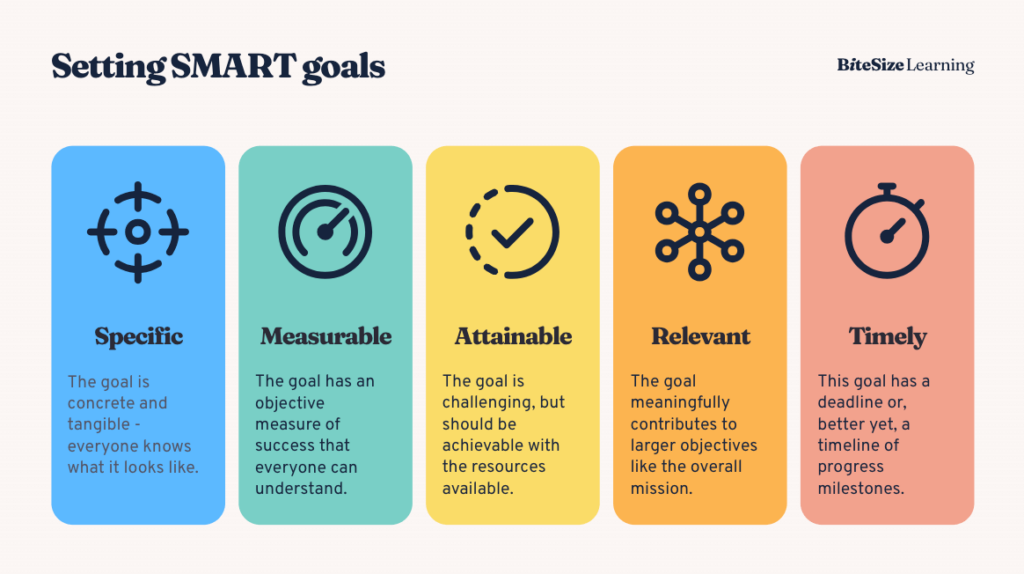We all have dreams and aspirations, but turning them into reality often requires more than just wishful thinking. The journey we undergo to reach our goals is often never linear, and sometimes we stop and question where to even begin. As a college student with my whole life ahead of me, my long-term professional career goal is clear as day, but presently seems almost out of reach. I once struggled to find where to begin, but by changing my method of creating long-term and short-term goals with the implementation of SMART goals, I am able to work towards my dreams and turn my aspirations into tangible accomplishments.

What are SMART goals? Well SMART goals are a simple yet effective strategy to help you thoroughly achieve your personal and professional objectives in a timely manner, with SMART standing for Specific, Measurable, Achievable, Relevant, and Time-bound.
Let’s break down each component:
- Specific: Your goal should be clear and concise. Ask yourself… What do I want to achieve, and how? For example, instead of saying, “I want to get better grades”, specify and instead say, “I want to get an A on my next Math Exam”.
- Measurable: Your goal should be done within a specific time frame to effectively track and evaluate your progress. For instance, “I will study 30 minutes each day” is more measurable than “I will study”.
- Achievable: Your goal should be realistic so that it is attainable. Setting an achievable goal means to take in consideration your resources, skills, and timeframe. For instance, “I will study all my math material the night before”, is not an ideal and realistic way to achieve an A, but by instead setting your goal by saying, “I will complete practice math problems 30 minutes daily for 2 weeks to get an A”, would be a more efficient and underwhelming way to achieve your goal.
- Relevant: Your goal should align with your short-term, long-term, and personal objectives to ensure it contributes and enhances your growth.
- Time-Bound: Your goal should be set in a clear timeframe in order to be achievable, and to hold yourself accountable. For example, “I will improve my GPA within 4 months” sets a sense of urgency to keep you accountable.

To give an example of what this might look like, I will use myself as a model of how I set my SMART goals to ensure effectiveness. As I previously mentioned, my ultimate objective as a college student is to step into the professional world and embark on my long-term goal to be a Data Scientist for the NBA. To begin, I will start off by identifying my objective to reach this long-term end goal, by creating a short-term goal.
Identify My Objective
In order to step into the professional field, I have to start out by gaining professional work experience, and a great way to do that is through internships. So ultimately, my objective is to secure an internship because it aligns to my long-term goal.
(S) Make My Goal Specific
Now that I have identified my short-term goal, how can I tie it back to my long-term goal to make it more specific? In my case, I look to pursue a career in the NBA which is a part of the entertainment industry, so a great way to make my goal more specific is to tailor my internship search to companies that are within the entertainment and sports industry, that offer internships related to data science.
(M) Make My Goal Measurable
I understand what to search for, and to make this goal measurable, I can quantify my goal to search and apply for 2-3 internships a week to track my progress as I continue trying to reach my goal of securing an internship position.
(A) Ensure Achievability
Taking into account my resources, and limited availability as an active college student, this goal is achievable and realistic for me and my schedule.
(R) Relevance is Key
This short-term goal is more than relevant in my professional development because the more experience I have under my belt concerning the relevant field and industry I am looking to get into, the more competitive my resume and job application will be in the future!
(T) Make It Time-Bound
Setting a deadline will allow me to look at my goal with urgency and accountability, but also making sure that timeline is attainable will help me effectively reach my goal. To do this, taking into account the established company internship deadlines, I will have to work towards securing an internship before the summer; more specifically, before the month of May.
Track and Adjust Accordingly
Regularly monitor your progress and make adjustments as needed. For example, if after a few weeks of applying to internships I have no luck getting an offer, I will adjust by increasing the number of times I apply each week that is still realistic considering all circumstances.
Overall, setting SMART goals is a powerful, neat strategy for personal, academic, and professional development. By making your goals Specific, Measurable, Achievable, Relevant, and Time-Bound, you can actively start turning your aspirations into reality and progressively begin accomplishing your short and long-term goals in an effective manner. Next time you’re looking to achieve a new goal, try utilizing this strategy and see just how much your progress will change!